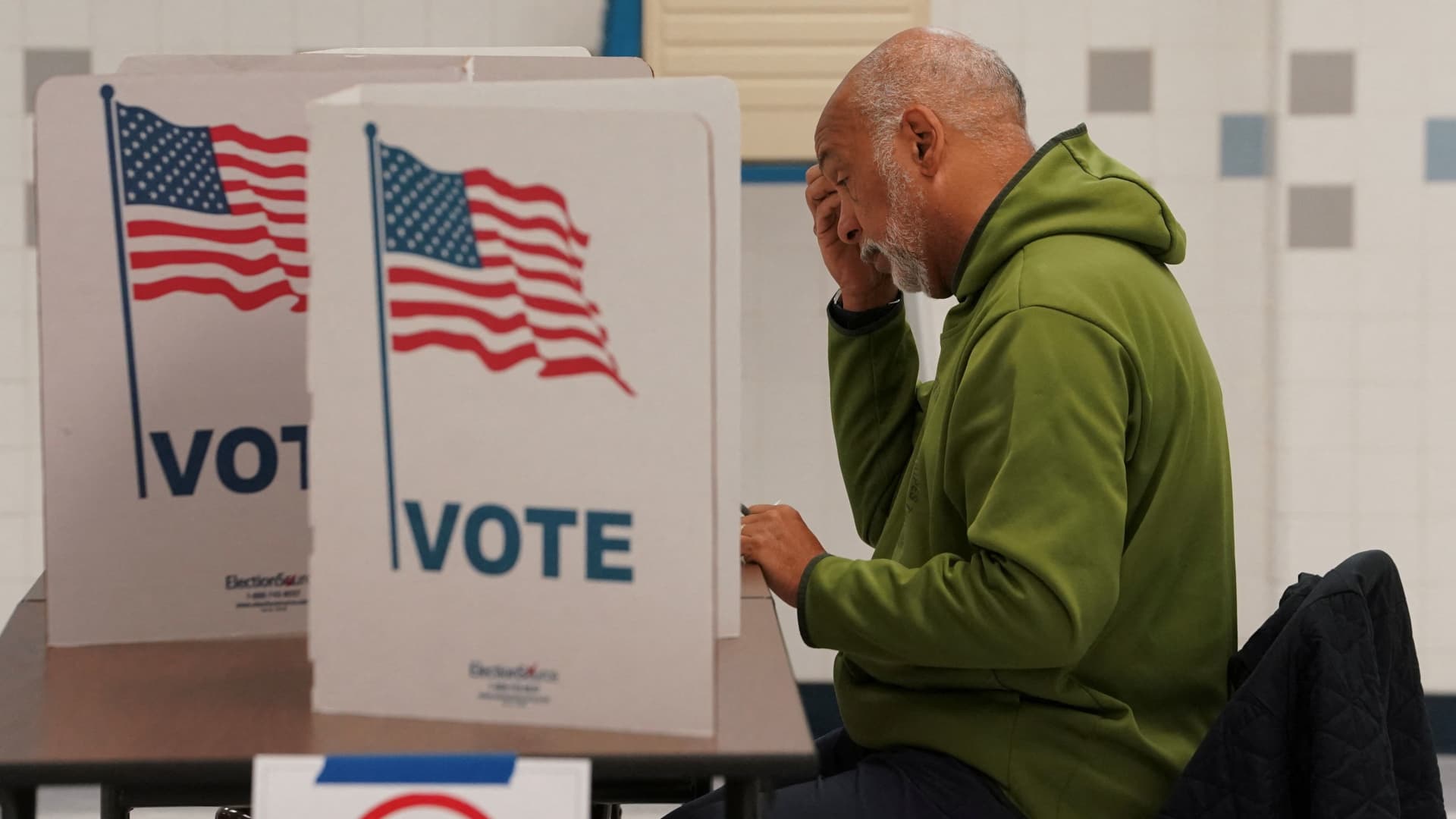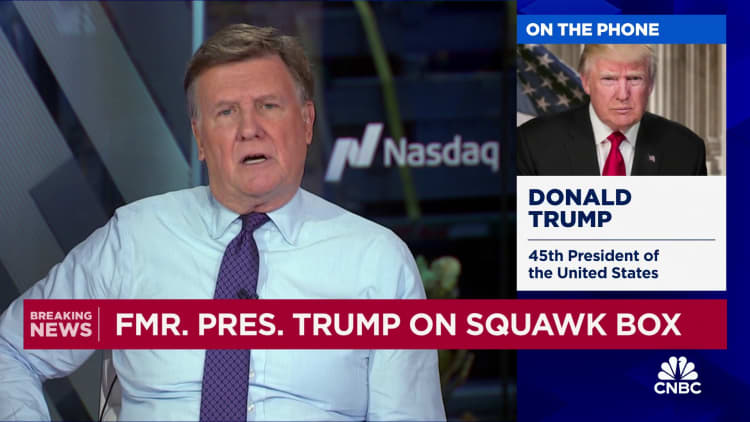A voter fills out a ballot at a polling station on Election Day in Falls Church, Virginia, U.S., November 7, 2023.
Kevin Lamarque | Reuters
When it comes to the November election, there is one issue that is at the top of voters’ wish lists: Social Security.
Despite political division, most Americans — 87% — want action to address Social Security’s trust fund shortfall, according to the National Institute on Retirement Security. The group polled 1,208 individuals aged 25 and older.
Meanwhile, 69% of Americans said a candidate’s stance on Social Security will be a major factor in how they vote in the presidential election, according to Nationwide Retirement Institute.
It polled 1,831 adults age 18 and up who “currently receive or expect to receive Social Security.”
While experts mostly agree a fix is needed, they are divided on how that should happen — whether it be through tax increases, benefit cuts or a combination of both.
The deadline to fix the programs will only grow more urgent during the next presidential administration.
“If something is going to happen before the eleventh hour, it is going to require presidential leadership,” said Emerson Sprick, associate director of the Bipartisan Policy Center’s Economic Policy Program. “That’s something we haven’t seen on this issue for a very long time.”
Projected depletion dates are looming
The latest projections from the Social Security trustees estimate the program’s combined funds may run out in 2035. At that time, just 83% of benefits may be payable. The projected depletion date for the trust fund used to pay retirement benefits is even sooner in 2033.
Medicare also faces a looming depletion date for its hospital insurance fund, which is projected to be able to pay 100% of benefits until 2036.
It is up to lawmakers to address the shortfalls before the projected depletion dates, when the programs will face across-the-board benefit cuts.
More from Personal Finance:
How a Harris presidency could shape a middle-class tax credit
JD Vance once called on GOP to fight student loan forgiveness
What a Kamala Harris administration could mean for your wallet
The looming depletion dates come as the programs face other pressures.
Retirees are now reaching “peak 65” — with more than 11,200 individuals turning 65 every day.
As more individuals rely on Social Security and Medicare, the gross national debt has now climbed to a record $35 trillion.
“We should fix our dangerously close to insolvent Social Security and Medicare trust funds,” Maya MacGuineas, president of the Committee for a Responsible Federal Budget, said in a statement.
Biden can ‘show leadership’ before presidency ends
U.S. President Joe Biden is flanked by family members as he speaks about the release of Americans detained in Russia during brief remarks at the White House in Washington, U.S., August 1, 2024.
Nathan Howard | Reuters
While the focus is on the presidential campaigns, President Joe Biden still has a window of opportunity to work to address Social Security and Medicare.
“Biden has a really fantastic opportunity, if he wants to get the ball rolling and show some leadership on the issue in the lame duck,” Sprick said.
Some Democrats have proposed raising taxes for the wealthy and increasing benefits.
Meanwhile, a bipartisan group of lawmakers has proposed forming a commission to identify next steps. But those efforts like those have yet to prompt action, which would likely require compromises.
“The folks in Congress need leadership and a little bit of cover from the top of the ticket,” Sprick said.
Biden publicly vowed to protect Social Security and Medicare and “make the wealthy pay their fair share” during his March State of the Union address.
“We could extend the life of Medicare’s Trust Fund permanently — without cutting benefits — if Congressional Republicans would get on board with the President’s historic budget proposal to raise taxes on the wealthy,” said White House spokesperson Robyn Patterson.
“The President’s budget also clearly states his principles for strengthening Social Security,” Patterson said. “He looks forward to working with Congress to responsibly strengthen Social Security by ensuring that high-income individuals pay their fair share, without increasing taxes on anyone making less than $400,000 or cutting benefits.”
Trump wants to eliminate some Social Security taxes
Republican presidential nominee and former U.S. President Donald Trump holds a campaign rally in Harrisburg, Pennsylvania, U.S., July 31, 2024.
Elizabeth Frantz | Reuters
Former President Donald Trump posted on Truth Social on Thursday, in all capital letters, “Seniors should not pay tax on Social Security!”
Experts say the post likely refers to the taxes Social Security beneficiaries may owe on their benefit income. The Trump campaign did not return a request for comment by press time.
Exactly how much Social Security beneficiaries pay in taxes is based on their “combined income,” which includes adjusted gross income, nontaxable interest and half of their Social Security benefits.
For individuals with $25,000 to $34,000 in combined income — or married couples who file jointly with between $32,000 and $44,000 — up to 50% of benefits are taxed.
For individuals with more than $34,000 in combined income — or married couples with more than $44,000 — up to 85% of benefits may be taxable.
Those thresholds are not adjusted for inflation. Consequently, as time passes and benefit income increases, more beneficiaries are liable for taxes on their benefits.
Nixing those levies would allow beneficiaries to keep more of their benefit income. But it would also reduce revenues for both Social Security and Medicare by about $1.6 trillion to $1.8 trillion between fiscal years 2026 and 2035, the Committee for a Responsible Federal Budget estimates.
Like Biden, Trump has mostly promised not to cut Social Security. Yet in a March CNBC interview, Trump said he would consider cutting “entitlements,” which may refer to Social Security, Medicare or Medicaid.
“There is a lot you can do in terms of entitlements, in terms of cutting and in terms of also the theft and bad management of entitlements,” Trump told CNBC’s “Squawk Box.”
Harris opposes benefit cuts
Democratic presidential candidate, U.S. Vice President Kamala Harris speaks at a campaign rally at the Georgia State Convocation Center on July 30, 2024 in Atlanta, Georgia.
Megan Varner | Getty Images
Vice President Kamala Harris’ position on Social Security and Medicare is similar to Biden’s, according to the White House.
Together, Biden and Harris have worked to extend Medicare’s solvency and give the program the authority to negotiate drug prices, thereby lowering costs for seniors and individuals with disabilities.
“The president and vice president oppose any proposal to cut benefits and have put forward a plan in the president’s budget to extend Social Security and Medicare solvency by asking the highest-income Americans to pay their fair share,” a White House official said.
As a senator representing California, Harris was a co-sponsor of the Social Security Expansion Act, which calls for raising taxes on the wealthy while making Social Security benefits more generous.
Once Harris was tapped to step in to the 2024 Democratic campaign for president, she readily got the endorsement of retirement advocacy groups.
“Unlike the GOP ticket, Vice President Harris has always been on the side of older Americans as a consistent supporter of Social Security, Medicare and lower drug prices,” Max Richtman, president & CEO of the National Committee to Preserve Social Security and Medicare, said in a statement.


 Blog Post7 days ago
Blog Post7 days ago
 Economics1 week ago
Economics1 week ago
 Personal Finance1 week ago
Personal Finance1 week ago
 Finance1 week ago
Finance1 week ago
 Finance1 week ago
Finance1 week ago
 Accounting1 week ago
Accounting1 week ago
 Accounting1 week ago
Accounting1 week ago
 Accounting1 week ago
Accounting1 week ago











